On a tight budget? Learn how to make a grocery list for a month with this helpful guide! I share tips and tricks that will save you money while shopping and meal planning.
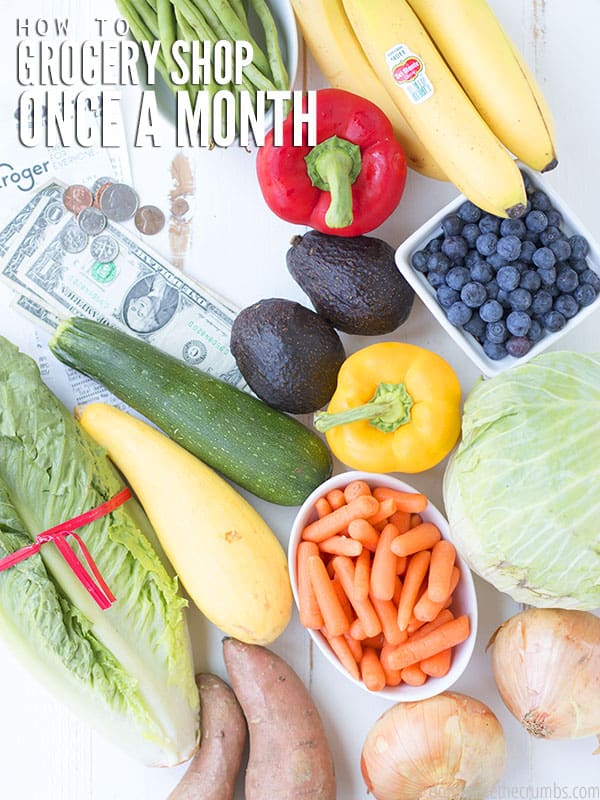
Buying healthy food for a whole family makes me feel like I’m constantly in the grocery store.
More bananas, more apples, more spinach, more butter… (darn those Healthy Chocolate Chip Cookies!).
But I also know that fewer trips to the grocery store are the best way to save money on food. Back when we were first learning how to eat real food on a budget, I made monthly meal plans and we only went to the grocery store for our monthly grocery shopping trip.
Our shopping has changed a little bit, but I know that learning how to grocery shop once a month is incredibly beneficial – whether to save time, money, or both!
Here’s my easy 8-step method for creating a monthly grocery list that fits YOUR family!
How to Create a Basic Grocery List for a Month
1 – START WITH A MONTHLY MEAL PLAN.
I will always be an advocate for planning first AND THEN shopping, so I recommend starting with a one-month meal plan before you leave the house.
You can follow my quick tutorial on how to meal plan once a month here, or if you need the hand-holding, you can get my course, Meal Planning Bootcamp. You can master my easy 5-step meal planning process in less than a week and start racking up the grocery savings immediately!
2 – REVIEW YOUR MENU PLAN.
Specifically, make sure the meals in that first-week use produce that are most perishable and meals later in the month use less perishable or frozen produce.
3 – REVIEW EACH RECIPE AND WRITE DOWN EVERYTHING YOU NEED, INCLUDING THE QUANTITY.
Do this for ALL breakfasts, lunches, dinners, snacks, and desserts. Also, double-check your list so you know you aren’t missing anything when you go shopping.
(If you don’t know how to plan for breakfasts or lunches, I teach that too in my course Meal Planning Bootcamp!)
4 – SHOP YOUR KITCHEN.
I recommend shopping in your kitchen before you even make your monthly plan, but it’s important to repeat this step here too. You certainly don’t want to buy a month’s worth of peanut butter only to find several jars already in the pantry!
And you definitely don’t want to find a bag of wilted spinach shoved in the back of the fridge at the end of the month when you could have used that instead of the new head of romaine on your list!
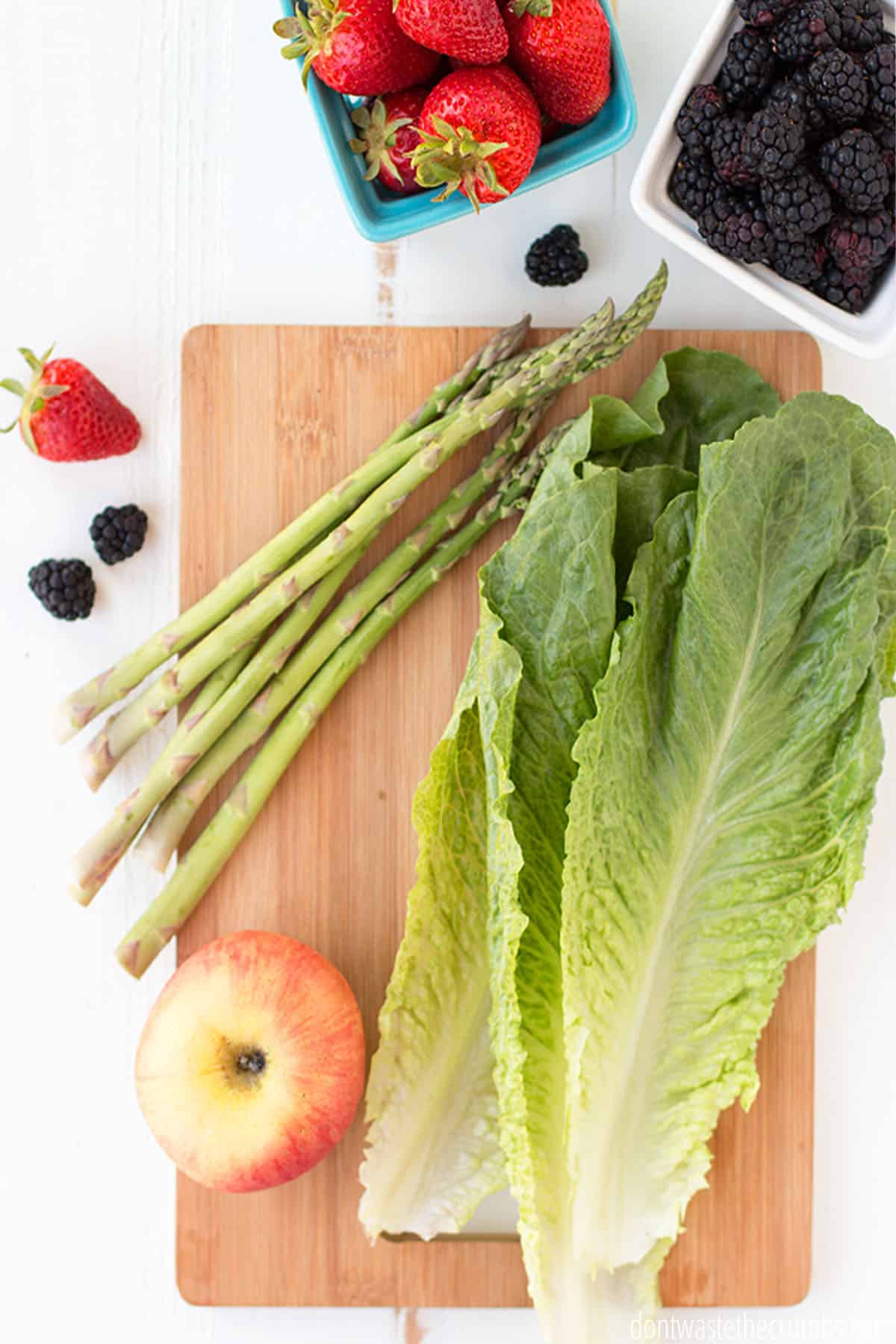
5 – AS YOU FIND WHAT YOU NEED IN YOUR KITCHEN, CROSS IT OFF YOUR LIST.
With what’s left on your essential grocery list, see if you can substitute what you have in your kitchen.
Be willing to freely swap things around. Some things won’t even be noticeable, like using different onions, a different potato, or a different squash!
6 – DECIDE WHEN YOU’RE GOING SHOPPING.
I don’t mean the day of the week, but rather decide if you’re shopping ONLY once for the whole month or if you’ll make a mid-month trip for perishables.
Both methods work well, but if you’re making a mid-month trip for things like milk and lettuce, you won’t need to buy them at the beginning of the month.
7 – GO SHOPPING!
Cross things off as you buy them, and check your list before you leave the store just to make sure you didn’t miss anything. This is a great job for your little helpers, if you have them, along with these other tips and tricks for keeping the kids busy while you SAVE.
Also, give yourself plenty of time so you’re not rushed and accidentally forget important things on your list.
8 – UNLOAD THE CAR AND PUT EVERYTHING AWAY.
Make sure perishable items don’t get hidden in the back of the fridge! Keeping your kitchen organized is an important way to save time in the kitchen.
The Benefits of Creating a Monthly Grocery List
- Save Time and Money: Plan your grocery needs for a month to save trips to the store and avoid overspending.
- Enjoy Freshness and Variety: With careful planning, you can still enjoy fresh vegetables and fruit throughout the month.
- Take Advantage of Bulk Purchases: Buy pantry items in bulk to stretch your budget.
- Cater to Dietary Needs: Plan for specific dietary requirements or health goals to ensure you have the right ingredients on hand.
- Reduce Stress and Decision Fatigue: With a well-organized grocery shopping list, meal planning becomes easier and less stressful.
- Embrace Creativity and New Recipes: Explore new delicious meals with the freedom of planning ahead.

What should be on my monthly grocery list?
In my experience, there is no one size fits all master shopping list that works for everyone. Families have a wide variety of dietary needs and preferences. Plus our schedules are different, or lifestyles vary, and there’s a wide variety of factors that make it hard to pin down a specific list for all.
However, I know that you’re busy and a master list could be helpful! Here’s a suggestion for pantry staple foods that fit a real food budget. I buy these items on a nearly monthly basis unless I can find cheaper ones in bulk.
Shelf Stable
- Rice (white rice or brown rice)
- Flour (or whole grains)
- Oats
- Beans (canned or dry)
- Popcorn
- Salt
- Broths (chicken or vegetable)
- Pasta
- Pasta sauce
- Canned tomatoes
- Condiments (unless you make your own)
- Salad dressings
- Spices and seasonings
- Honey
Frozen
- Mixed veggies
- Broccoli
- Corn
- Cauliflower
- Green beans
- Peas and carrots
- Blueberries
Fresh foods that can be frozen if needed to last longer
- Eggs
- Cheese
- Yogurt
- Fruit (strawberries, bananas, peaches, pineapple, etc)
- Bell peppers
- Onions
- Meats (including lunch meat)
- Bread
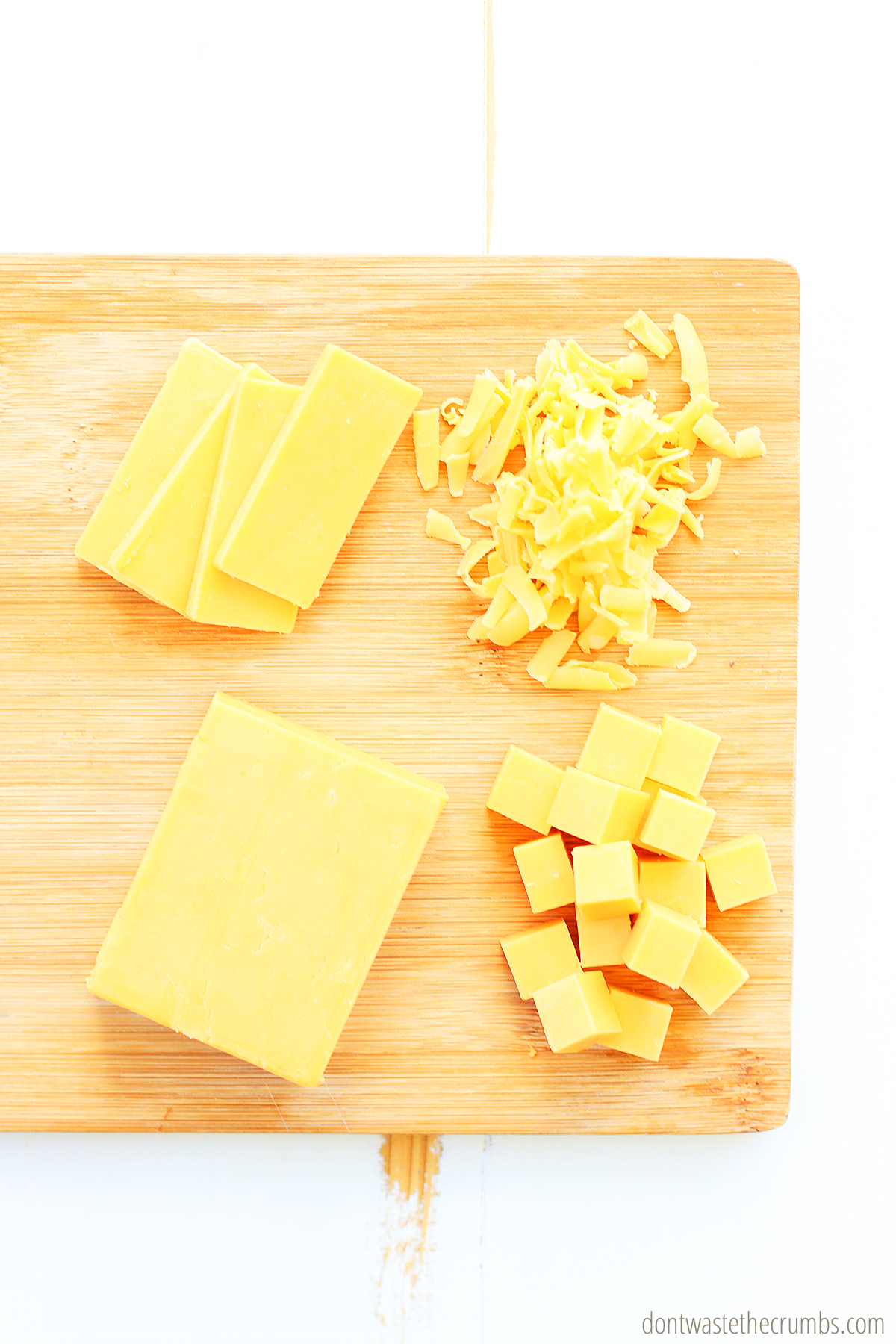
FAQs
Is it possible to create a cheap grocery list while still buying fresh produce?
Absolutely! Look for seasonal fresh fruits and vegetables, shop at your local grocery store for deals, and consider frozen options with a long shelf life, like frozen fruit and vegetables.
What are some budget-friendly protein options to include in my grocery list?
Fresh meat like ground beef, chicken thighs, and chicken breasts are affordable choices. Buying in bulk or opting for store brands can also save you money.
Are frozen fruits and vegetables as nutritious as fresh ones?
Yes, frozen produce is often harvested at its peak and retains its nutritional value. It’s a great way to enjoy affordable and nutritious options, especially when fresh fruits or vegetables are out of season or expensive.
How can I reduce food waste and save money?
Plan your meals in advance, buy only what you need, and use up ingredients before they spoil. Properly store perishables, repurpose leftovers and consider freezing food items for later use.
How can I make the most of my grocery budget with limited funds?
Shop strategically and consider generic brands or store brands for affordable alternatives. Also, take advantage of discounts, coupons, and cashback apps to maximize your savings.
Create Monthly Grocery List: Final Thoughts
Creating a budget grocery list for one month is a savvy strategy that can work wonders for your wallet, meal planning, and shopping routine. By taking the time to craft a well-planned grocery list, you’ll unlock a world of benefits. We talk about this in-depth in my course Grocery Budget Bootcamp (enrollment is currently closed, but you can join my FREE 5-day Crush Inflation Challenge and start saving money on groceries tomorrow!) Try out some of these tips, and let me know how it goes in the comments below!
More Grocery Shopping Tips
- Fail-Proof Grocery Saving Tips That Work Every Time
- How to Stick to Your Grocery Budget
- 5 Ways to Reduce Grocery Spending
- How to Save Money with Grocery Delivery
- Walmart Grocery Pickup: My Personal Experience and Honest Review
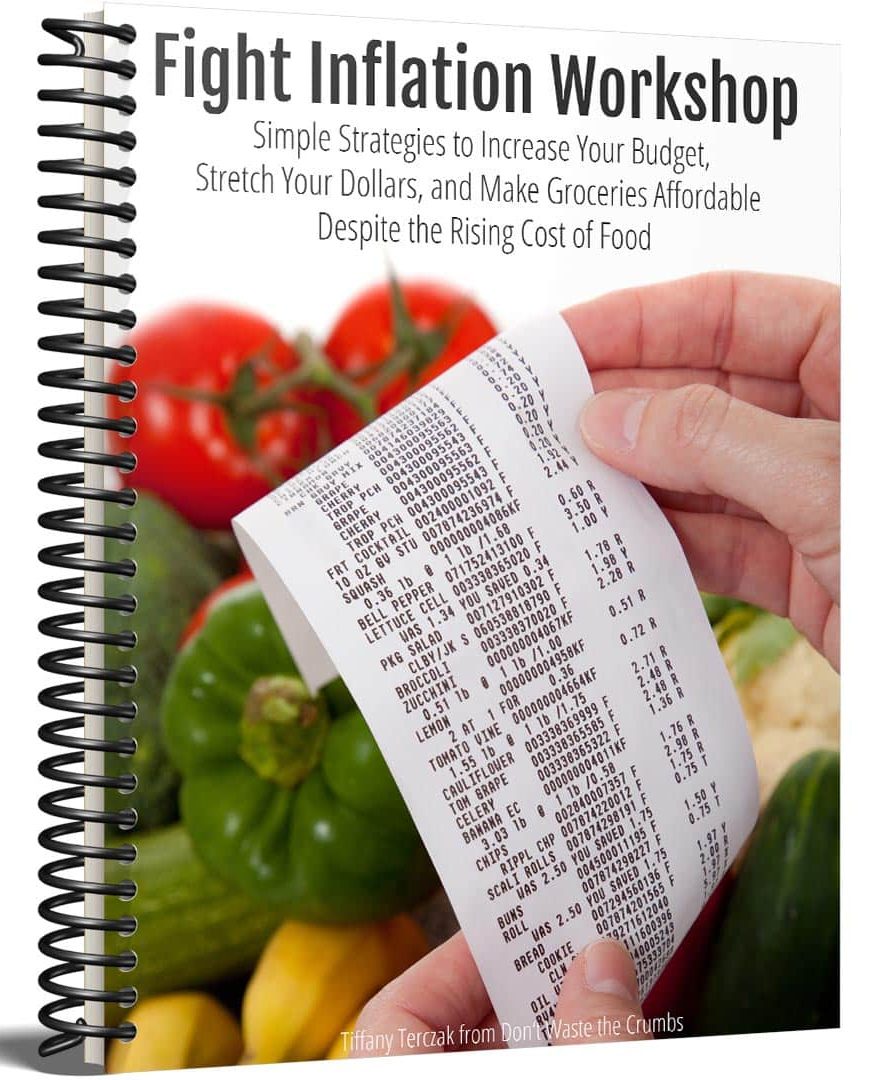

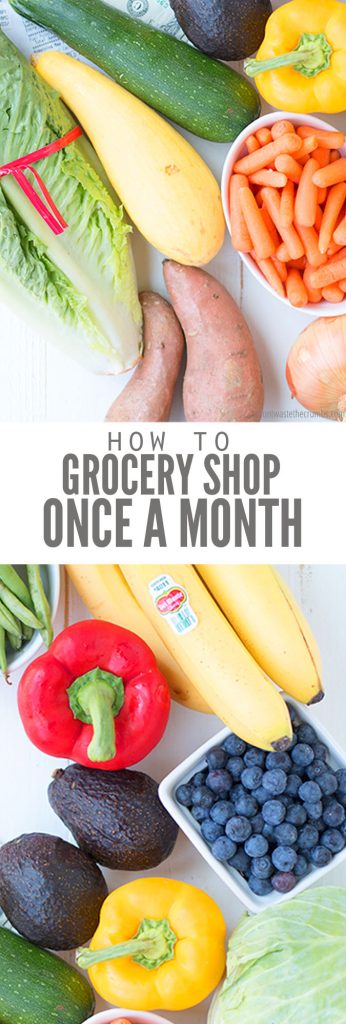





Can you help start a movement asking stores to sell groceries in smaller packages WITHOUT raising the price? I live alone and it is impractical and at the end, impossible to use everything I buy without wasting either food, or energy saving it, and at the end, tossing it anyway, with great sadness since too much time was put in trying to find ways to save it in different ways. Only in the US sliced bread is sold in “standard” package size. I am sure it can be changed if enough people persuade companies to rethink this.
Hello Elena,
Tiffany says, Unfortunately package sizes are determined by the food manufacturers. Your best option is to change the approach to how you shop. It is VERY possible to use everything you buy without throwing anything away! I encourage you to review my membership Grocery Budget Mastermind (https://dontwastethecrumbs.com/go/gbm/), or join my free Crush Inflation Challenge (https://dontwastethecrumbs.com/go/cic/).
Shopping once a month will save you on gas for the car. So that in itself is a reason to shop only once a month.
Fruits and veggies do not always have to be eaten in their raw, natural form. For example, when bananas are past their prime, mash them and even freeze them to make banana bread later on. And you can freeze the baked goods you have made at home as well.
Many veggies can be cooked and then frozen and eaten at a later date.
Milk, buttermilk, etc. can be frozen and used at a later date.
And you can dehydrate many foods to be used in recipes later. A good example is sliced mushrooms but there are many other choices.